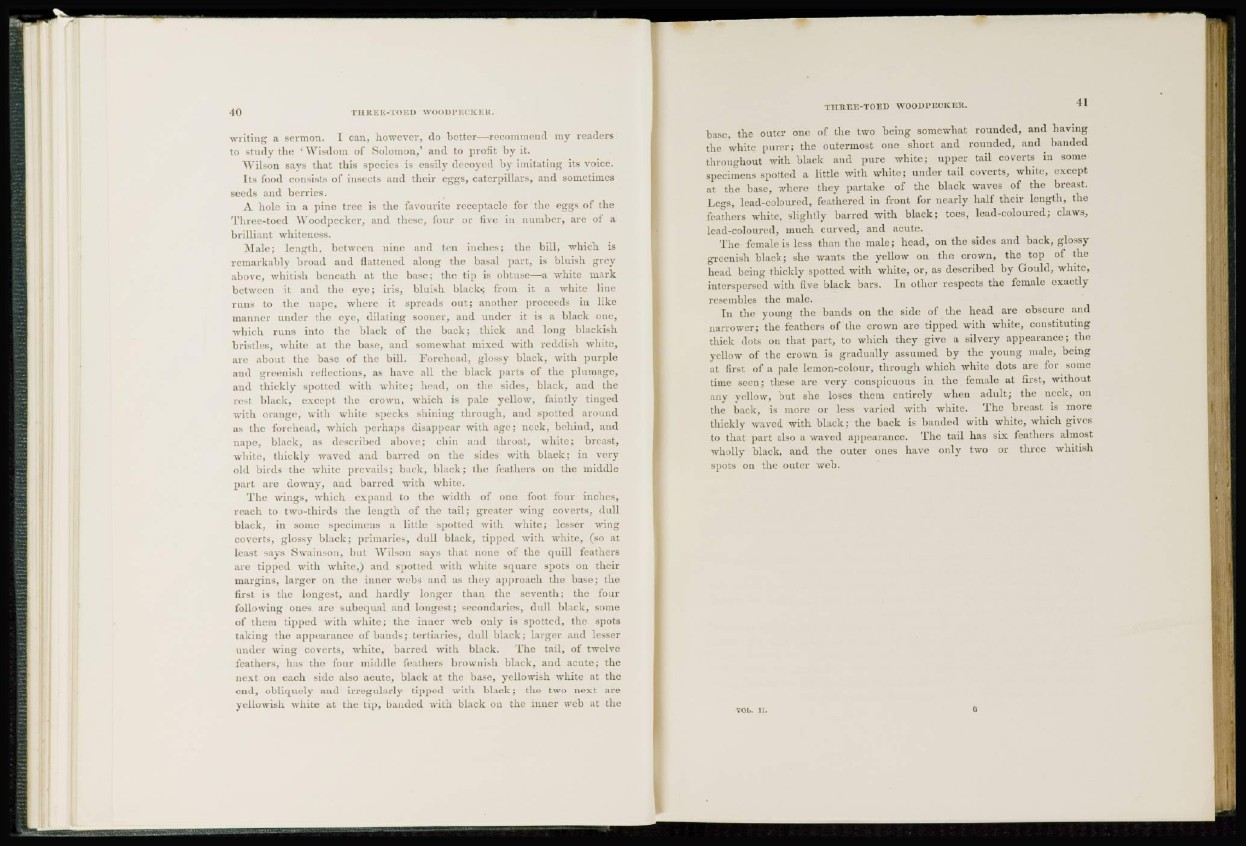
lit T H R E E - T O E D W O O D P E C K E R.
writing a sermon. I can, however, do hotter—-recommend my readers
to study the 'Wisdom of Solomon,' and to profit by it.
Wilson says that this species is easily decoyed by imitating its voice.
Its food consists of insects and their eggs, caterpillars, and sometimes
seeds and berries.
A hide in a pine tree is the favourite receptacle for the eggs of the
Three-toed Woodpecker, and these, four or five in number, are of a
brilliant whiteness.
Male; length, between nine and ten inches; the bill, which is
remarkably broad and flattened along the basal part, is bluish grey
above, whitish beneath at the base: the tip is obtus<—a white mark
between it ami the eye; iris, bluish black; from it a white line
runs to the nape, where it spreads out; another proceeds in like
manner under the eye, dilating sooner, aud under it is a black one,
winch runs into the black of the back; thick and long blackish
bristles, white at the base, and somewhat mixed with reddish white,
are about the base of the bill. Forehead, glossy black, with purple
and greenish reflections, as have all the black parts of the plumage,
and thickly spotted with while; head, on the sides, black, and the
rest black, except the crown, which is pale yellow, faintly tinged
with orange, with white specks shining through, aud spotted around
as the forehead, which perhaps disappear with age; neck, behind, and
nape, black, as described above; chin and throat, white; breast,
while, thickly waved and barred on the sides with black; in very
old birds the white prevails; back, black; the feathers on the middle
part are downy, and barred with white.
The wings, which expand to the width of one foot four inches,
reach to two-thirds the length of the tail; greater wing coverts, dull
black, in some specimens a little spotted with white; lesser wing
coverts, glossy black; primaries, dull black, tipped with white, (so at
least says Swainson, but WILSON says that none of the quill feathers
arc tipped with white,) and spotted with white square spots on their
margins, larger on the inner webs and as they approach the base; the
first is the longest, and hardly longer than the seventh; the four
following ones are subequal and longest; secondaries, dull black, some
of them tipped with white; the inner web only is spotted, the spots
taking the appearance of bands; tertiaries, dull black; larger and lesser
under wing coverts, white, barred with black. The tail, of twelve
feathers, has the four middle feathers brownish black, and acute; the
next on each side also acute, black at the base, yellowish white at the
end, obliquely and irregularly tipped with black; the two next are
yellowish white at the tip, banded with black on the inner web at the
base, the outer one of the two being somewhat rounded, and having
the white purer; the outermost one short and rounded, and banded
throughout with black and pure white; upper tail coverts in some
specimens spotted a little with white; under tail coverts, white, except
at the base, where they partake of the black waves of the breast.
Legs, lead-coloured, feathered in front for nearly half their length, the
feathers white, slightly barred with black; toes, lead-coloured; claws,
lead-coloured, much curved, and acute.
The female is less than the male; head, on the sides and back, glossy
greenish black; she wants the yellow on the crown, the top of the
head being thickly spotted with white, or, as described by Gould, white,
interspersed with five black bars. In other respects the female exactly
resembles the male.
In the young the bands on the side of the head are obscure and
narrower; the feathers of the crown arc tipped with white, constituting
thick dots on that part, to which they give a silvery appearance; the
yellow of the crown is gradually assumed by the young male, being
at first of a pale lemon-colour, through which white dots are for some
time seen; these arc very conspicuous in the female at first, without
any yellow, but she loses them entirely when adult; the neck, on
the back, is more or less varied with white. The breast is more
thickly waved with black; the back is banded with white, which gives
to that part also a waved appearance. The tail has six feathers almost
wholly black, and the outer ones have only two or three whitish
spots on the outer web.